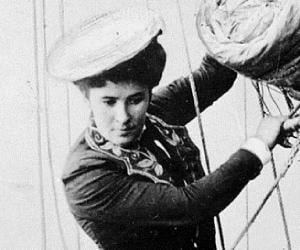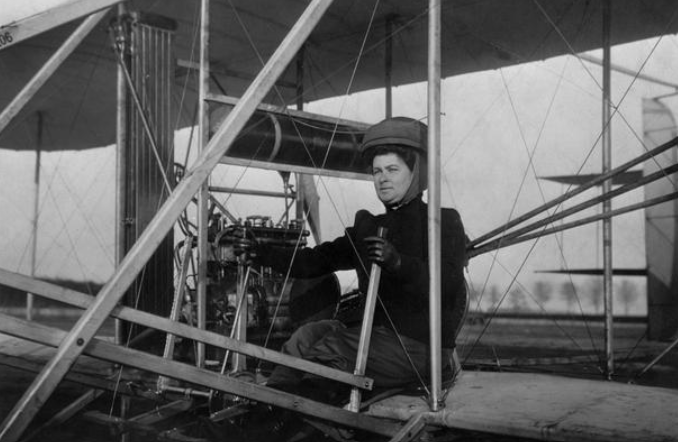Famed under the stage name Miss Polly and celebrated as the first female aviator to tour with international circus shows, Katharina Paulus carried deep personal tragedy behind her public success. Dressed in the extravagant costumes of her era, she performed with the “bicycle balloon” and trapeze, parachuted from balloons using her own handmade parachutes, and at the peak of her career as an aerial acrobat, she captivated thousands of spectators. Even while enduring profound losses in her life, Paulus remained devoted to aviation until her very last days.
In the final quarter of the 19th century, Paulus, a German who worked as an acrobat in circuses and had trained as a seamstress, first encountered aviation through circus acts. Together with her partner Carl Diening, she participated in public events with hot air balloon demonstration flights. After Carl’s death, she continued performing on her own. In 1889, she met the famous pilot and parachutist Hermann Lattemann, from whom she learned ballooning and parachuting. Quickly becoming both his professional and personal partner, Paulus climbed to 1,200 meters in 1893 and became the first woman in Germany to parachute from a balloon. This leap marked the beginning of her long career as an aerial acrobat and later as the country’s first professional airship pilot. Worldwide, she became only the third woman ever to parachute, after pioneers Jeanne-Geneviève Labrosse (1775–1847) and Élisa Garnerin (1791–1853).
Paulus continued her balloon performances with Lattemann as part of the show business scene. The couple had a child and later toured together with acrobatic acts. But tragedy struck: just one year after Paulus’s historic parachute jump, in 1894, Lattemann was killed in a parachute accident. A year later, their young son also passed away. Devastated, Paulus spent months bedridden in grief. During this time, she received thousands of letters from fans urging her to continue her ballooning career. Their support pulled her back into life, and rather than stepping away, she immersed herself even more deeply in aviation and performance.
Performing under her stage name Miss Polly, Paulus pursued aviation with full dedication. She toured Europe, staged acrobatic acts, and even rode a bicycle dangling from a hot air balloon basket in theatrical shows. Gaining international fame, she purchased one of the first motorized airplanes and began flight training. However, after her instructor was killed in an accident, she abandoned the lessons and chose to continue exclusively with balloons. With the outbreak of World War I, she was forced to stop flying and turned instead to parachute development.
In fact, Paulus had already begun experimenting with parachutes after Lattemann’s death, determined to improve their reliability in adverse weather, believing his death might have been prevented. Drawing on her tailoring skills, she came up with the revolutionary idea of folding the parachute fabric and suspension lines into a compact pack, secured with a mechanism that allowed controlled deployment. The genius of her design was that it prevented the suspension lines from tangling during opening. With this, Paulus invented the modern foldable parachute.

In 1915, Käthe Paulus registered her invention as a “device for attaching parachutes to aircraft” with the Imperial Patent Office (Kaiserliches Patentamt). At first, the military was skeptical, but by 1916 her innovation gained attention, and she received an order for 7,000 parachutes. Production took place in her Berlin-Reinickendorf workshop with around 30 seamstresses, each parachute stamped with the quality mark “KP.” Until then, parachutes had been too bulky to fit in backpacks, but Paulus’s foldable design proved invaluable, especially for the German army during the war. Producing about 125 parachutes per week, Paulus also invented the drogue chute, a small parachute that deployed first to extract the main parachute, using a deliberate breakaway system. As one of the first large-scale parachute manufacturers, Paulus was awarded the War Aid Merit Medal in 1917. She later secured patents for her invention in Austria (1920) and Switzerland (1921).
After the war, Paulus’s health declined, and she retired from aviation. Nevertheless, her contributions left a lasting impact, helping shape the future of modern flight. She passed away in 1935 at the age of 66 and was buried in Berlin. Today, Käthe Paulus is remembered as a pioneering figure in parachute design and technology—her invention has saved countless lives and set enduring standards in parachute systems. Her name continues to live on in Germany, honored through schools, streets, and tributes that celebrate her extraordinary legacy.



